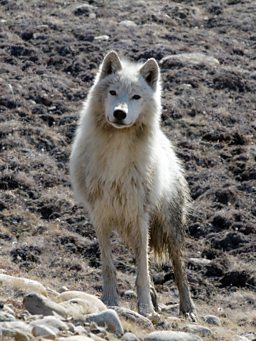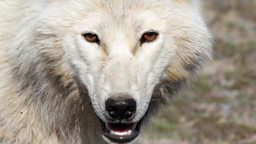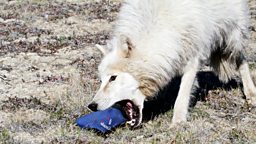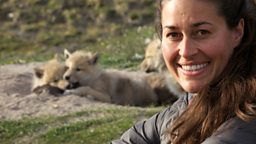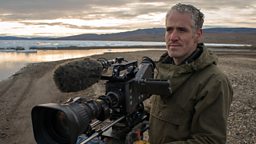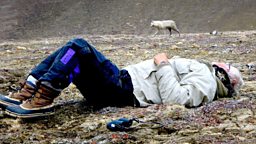What鈥檚 in a wolf鈥檚 stare?
Patrick Evans, producer
What’s in a wolf’s stare? Is it a cold killer’s glare, or pure curiosity?
Seeing so much intelligence so close up in this wild predator is addictive.Patrick Evans
Wolves on Ellesmere Island in the Canadian Arctic are reputedly unafraid of people. This doesn’t necessarily make them dangerous; attacks on humans are extremely rare and even then are usually due to rabies, so I felt very relaxed in the company of Arctic wolves, perhaps too much so at times.
In early June, we flew hundreds of miles looking for wolves. Our helicopter pilot was a daredevil in his mid-seventies with a habit of falling asleep instantly whenever we set down, and sometimes while he was flying. We zipped across still-frozen fiords, which were dissolving sluggishly into soupy blue-green chasms of mucky dark slush, and prayed we wouldn’t have to bail out. The pattycake polar desert was relentlessly brown but still mesmerising, undulating constantly, and capped by crisp snowbank shells.
Eventually, after days of fruitless searching, we landed at our last chance saloon, a remote, shallow valley where a wolf pack had been noticed some years before. Climbing a hill to scour for clues, one of us spotted five or six tiny white dots, many miles away on the horizon, shimmering into view through the Arctic summer heat haze. They had seen us first. As we watched, the dots quickly resolved into wolves borne like trotting magnets quickly straight towards us over the lolloping tundra.
As they approached, I sat down on the gravel slope beside American wolf biologist Dan MacNulty. A young adult female walked right up, circling round, first in front, then above and behind us. The look in her eyes spoke of serenity, almost as if she was glad or amused to find these odd strangers in her world. Photographs I took at that moment seem to suggest she was smiling.
Several weeks later, I had a very different encounter with the same wolf. By then, we had named her Atka, which means ‘guardian’ in Inuktitut, because of her role helping the pups’ mother. On this occasion, I was sitting apart, making sound recordings near the den, when she suddenly stood, and walked unhesitatingly towards me. Initially, I thought she might just be inquisitive. But as I watched her looming so large through my telephoto lens that her face more than filled it, I noticed her eyes were different. They were fixed, impassive, terrifying. A hunter’s focussed glare. I was kneeling, and she was on the slope above me, only a metre or two away. She must have been able to hear my heart thumping wildly.
Snapping her head close to the ground, she whipped my boom microphone from under my feet. The windsock! She thought it may have been a hare. Or, in any case, since I was on her patch, she was entitled to it, whatever it was. Luckily the attached microphone cable reached its limit, snatching it from her teeth, and I was able to retrieve it. As a consolation, I took off my cap, and threw it for her. She stole it gratefully, chewed and rolled on it, watching me naughtily as she did so through the corner of her eye. Then she decided she was bored, and returned once more for the windsock, which was what she really wanted. I stood up, and deterred by my taller presence, she sauntered off up to our camp instead, looking for mischief.

Atka the snow wolf vs. microphone
Atka gets a little too close for comfort.
Wolves are capable of so many different expressions. Towards the end of our time on Ellesmere, we watched another wolf, Scruffy, staring into the eyes of our cameraman and presenter, Gordon, in a scene featured in the second film in the series. The wolf seemed delighted, almost spellbound, innocently desperate to get closer to this man, who looked as if he might become a great new friend.
The look in her eyes spoke of serenity, almost as if she was glad or amused to find these odd strangers in her worldPatrick Evans
Seeing so much intelligence so close up in this wild predator is addictive. It makes you want to take the next step, and live with them as we do with our dogs. It makes you respect them, a respect tinged with a little bit of fear. But mostly it’s we who are just as curious as they are, about the highly sensitive being that lurks behind the wolf’s big bad reputation.
